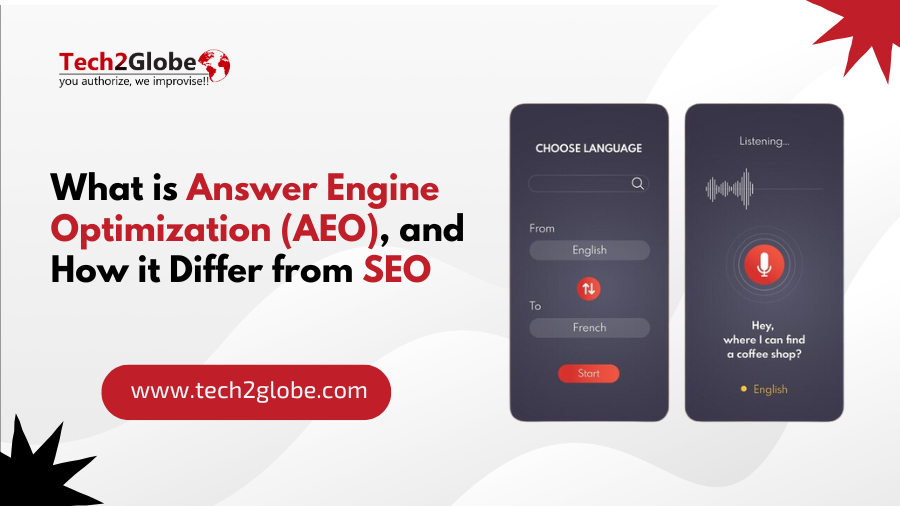Summary: Do you know how AEO differs from SEO? While SEO boosts website rankings, AEO provides direct answers in search results and voice search. Want to optimize both? Read our latest blog explaining the core differences and best practices of SEO vs. AEO to learn more!
Among industry professionals, be it digital marketers and website owners, search engine optimization (SEO) has been a beneficial approach for a long time. With the rise of SEO vs. AEO, however, some marketing campaigns have grown by huge amounts, leveraging both strategies for better visibility.
AEO is now seen as a game-changer in digital marketing, complementing SEO consistency in driving visibility. However, their approach has a huge difference, especially in how they deliver information—SEO focuses on rankings, while AEO provides direct answers. To understand AEO advantages and how you can optimize it without compromising SEO, continue reading for expert strategies.
Key Takeaways
- AEO provides direct answers in search results and voice search, unlike SEO which drives website traffic.
- Nearly 50% of searches are expected to be voice-based by 2025, making AEO crucial for visibility in voice assistants.
- Optimizing for AEO boosts chances of appearing in featured snippets, positioning content as the primary answer.
- Schema markup aids search engines in understanding content, enhancing visibility in answer boxes.
- AEO builds credibility and user trust, complementing SEO and maintaining brand relevance in both traditional and AI-driven searches.
What is AEO vs SEO?
In simple terms, AEO vs. SEO is about how content reaches users. AEO focuses on optimizing for answer boxes and voice search results, ensuring quick, direct answers. Meanwhile, SEO remains essential for improving website rankings and driving traffic. Both strategies play a vital role in digital marketing, enhancing visibility and engagement in different ways.
What is Answer Engine Optimization (AEO)?
Answer Engine Optimization (AEO) is the process of organizing and improving information so that it gives users quick, appropriate answers right in the search engine results pages (SERPs). AEO seeks to have information shown immediately in answer boxes, snippets, and voice search replies, unlike conventional SEO, which emphasizes ranking websites higher to draw clicks. Without leaving the search results page, these quick responses enable consumers to locate the required information.
Especially voice assistants like Google Assistant, Siri, and Alexa, AEO evolved from the fast changing consumer expectations and the emergence of AI-driven search technology. Natural language is used by people more and more for searches; AEO enables content to properly answer these question-based searches. Here are Interesting facts about AEO:
- Nearly 60% of Google searches end without clicks, making AEO essential.
- Almost 50% of searches could be voice-based by 2025, reinforcing AEO’s importance.
- AEO optimization can increase organic visibility by over 100%.
- Implementing schema markup enhances AEO rankings in search results.
Key Elements of AEO
Here’s the AEO features overview:
- Featured Snippets: Short replies at the top of SERPs for question-based queries.
- Knowledge Panels: Summarizes significant information on notable people, places, and organizations.
- People Also Ask (PAA): Displays similar queries in drop-down style.
- Voice Search: Essential for voice-activated devices to give single-answer material.
How does it work?
An example to help you understand how AEO works: Imagine you ask your voice assistant, “What’s the best way to remove coffee stains from clothes?” Instead of listing multiple websites, it reads out a direct answer like, “Blot the stain, apply baking soda and vinegar, then wash as usual.”
This is Answer Engine Optimization (AEO) at work. Unlike traditional search results, AEO ensures that content is structured to provide immediate, concise, and relevant answers—whether through voice search, featured snippets, or answer boxes. Businesses optimizing for AEO increase their chances of being the go-to source for quick solutions, enhancing brand visibility even if users don’t visit their website.
The Benefits of AEO in Digital Marketing
- Improved SERP visibility: Content in highlighted snippets or knowledge panels is more authoritative and relevant to user inquiries. These appearances build brand authority without clicking.
- Voice Search Engagement Improved: Voice search is becoming more popular, especially with mobile devices and smart home assistants. AEO helps you become the go-to answer for voice-based queries by linking your content with quick information seekers.
- Authority and credibility increased: Your material appearing in answer boxes and highlighted snippets establishes your business as a trustworthy information source, which boosts SEO.
- Matching User Expectations: AEO advises structuring material to be digestible and instructive. These methods satisfy consumers’ expectations and build trust between the brand and its audience.
Key Differences Between AEO and SEO
Although both Search Engine Optimization (SEO) and Answer Engine Optimization (AEO) target raising the visibility and relevance of a website in search results, they address various facets of search engine results pages (SERPs). From creating traffic to offering straight responses, knowing the difference between AEO vs SEO can assist companies in optimizing their material to satisfy both conventional and new user expectations.
| Features | Search Engine Optimization (SEO) | Answer Engine Optimization (AEO) |
| Primary Goal | Rank higher in SERPs to drive organic traffic to a website. | Provide direct, concise answers to user queries, often appearing in featured snippets, knowledge panels, or voice search results. |
| Focus | Optimizing website content and structure to align with search engine algorithms. | Optimizing content to directly answer specific questions and provide quick, valuable information. |
| Content Type | Long-form content (blog posts, articles, web pages) that comprehensively covers a topic. | Short, concise answers, often in question-and-answer format, lists, or bullet points. |
| Keywords | Targets a range of keywords, including long-tail keywords and related terms. | Focuses on specific question-based keywords and phrases that users are likely to ask. |
| User Intent | Addresses a broad range of user intents (informational, navigational, transactional). | Focuses on answering specific questions and providing immediate solutions. |
| Search Platform | Primarily targets traditional search engines like Google, Bing, and Yahoo. | Optimizes for AI-driven search engines, voice assistants (Siri, Alexa), and featured snippets. |
| Metrics | Tracks website traffic, keyword rankings, bounce rate, and time on page. | Measures visibility in featured snippets, voice search results, and click-through rates on direct answers. |
| Technical Aspects | Emphasizes website structure, page speed, mobile-friendliness, and technical SEO elements. | Focuses on structured data markup (schema.org) to help search engines understand the content and provide direct answers. |
| Evolution | Traditional SEO practices are evolving to incorporate AEO principles. | AEO is emerging as a crucial component of a comprehensive digital marketing strategy. |
How Does AEO Impact the Future of SEO?
Some marketers worry that Answer Engine Optimization (AEO) might reduce website traffic since users get answers without clicking. However, AEO isn’t a threat—it complements SEO.
As zero-click searches rise, brands can stay visible by appearing in direct answers, building trust even without clicks. Instead of just driving traffic, AEO focuses on engagement and credibility. Optimizing for both ensures a strong presence in search results.
Moreover, AEO encourages concise, user-friendly content that search engines favor. By aligning SEO with AEO, businesses can capture attention, enhance authority, and drive awareness, making it a powerful strategy for digital success.
How to Optimize for Both AEO and SEO Effectively
Here are the main techniques to maximize for both AEO and SEO:
Emphasize addressing user inquiries.
Find typical queries in your area of expertise and organize your content accordingly. Indicate direct responses for particular searches using headers, for example: “how to guides”.
Use question-based phrases and long-tailed keywords.
Long-tail keywords, particularly for voice searches, match natural language queries. Relevant questions consumers are looking for in your sector may be found using tools like Answer The Public and Google’s People Also Ask feature.
Apply a schema. Markup for Structured Information
Helping search engines to grasp the context of your material depends on structured data—schema markup. Markup styles like FAQ schemas or How To schemas increase the likelihood that your comments would show up in voice responses or snippets.
Knowledge panels and featured snippets.
Arrange your material such that it clearly addresses concerns inside the first 100 to 200 words of a page, as highlighted snippets are more likely to show up. Where appropriate, enhance readability with lists, bullet points, and tables.
Offer authoritative, high-quality content.
Google loves material with great E-A-T (experience, expertise, authority, and trustworthiness). To increase the possibility for AEO rating, make sure your material is accurate, well-researched, and well-evaluated.
Add summaries and visuals.
Charts, infographics, and images can enhance the appeal of the material and increase its likelihood of selection for the answer boxes. For increased AEO appeal, summarize responses inside headers and at the start of articles.
Conclusion
Answer Engine Optimization (AEO) prioritizes the user’s purpose and desire for quick responses, rather than serving as a replacement for SEO. Stressing AEO and SEO can help you to improve exposure, increase brand authority, and keep a competitive edge in search results. Adopting AEO and SEO guarantees that you will attract user attention on the SERP and translate it into devoted consumers, therefore enabling you to address their demands in many different ways.
Understanding how to modify SEO for AEO and using these techniques will help you succeed in the search of the future, in which the relevancy and quality of responses really count.
Also Read:
Big Announcement: Tech2Globe at IndiaSoft 2025!
Google Ads Search Max: Is “Search Max” the Next Big Thing in Google Ads?
Amazon’s 2025 title policy update – New product title requirements effective January 21, 2025










